Pakistan is a land full of history and diverse culture. It’s a treasure waiting to be explored. From ancient ruins to grand Mughal architecture, its heritage is rich. The country’s vibrant traditions, mystical shrines, and colorful festivals make it even more special.
But, challenges like neglect and lack of awareness threaten these treasures. Join us as we explore Pakistan’s cultural landscape. We’ll see the good, the bad, and the ugly, and why preserving its heritage is key.
Pakistan’s culture is a mix of ancient civilizations, Islamic influences, and regional diversity. The Indus Valley Civilization ruins show its ancient past. The Gandhara civilization, with its Buddhist influences, adds another layer to its heritage.
Mughal architecture, like the Lahore Fort and Badshahi Mosque, shows the Mughal era’s grandeur. Sufi shrines, such as the Shrine of Shah Abdul Latif Bhittai, attract devotees from all walks of life.
But, preserving Pakistan’s heritage is a big challenge. Historical sites face neglect and deterioration. The walled city of Lahore needs conservation efforts. Folk traditions and craftsmanship, like truck painting and embroidery, are at risk.
The lack of awareness among the younger generation is another concern. Despite these challenges, there’s hope for Pakistan’s heritage. Efforts to restore historical sites, like the Lahore Fort, are underway. Cultural festivals, like the Kalash Valley festival, showcase the country’s diversity.
By promoting cultural education and pride in heritage, we can preserve these treasures. This way, future generations can cherish and admire them.
Key Takeaways
- Pakistan boasts a diverse cultural heritage shaped by ancient civilizations, Mughal influences, and folk traditions.
- The country is home to iconic sites such as the Indus Valley Civilization ruins, Mughal architecture, and Sufi shrines.
- Challenges such as neglect, deterioration, and lack of awareness threaten the preservation of Pakistan’s cultural heritage.
- Efforts are being made to restore historical sites and promote cultural festivals to safeguard the country’s rich heritage.
- Promoting cultural education and fostering pride in Pakistan’s heritage is crucial for preserving it for future generations.
Introduction to Pakistan’s Cultural Landscape
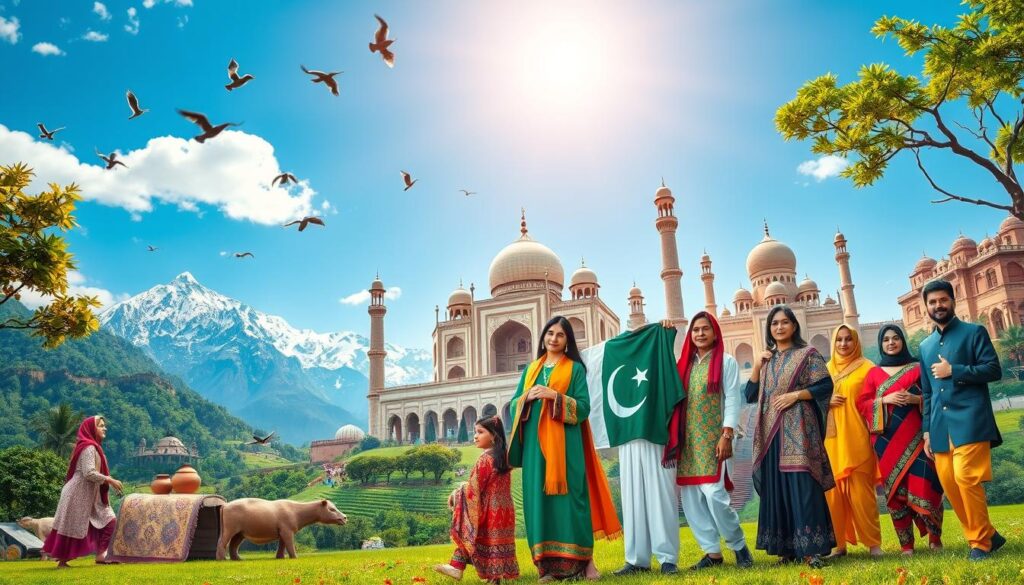
Pakistan’s culture is a colorful mix of different historical and regional traditions. It sits at the meeting point of ancient civilizations. This has shaped Pakistan’s history, from the Indus Valley ruins to the Mughal monuments.
The country’s diversity is truly remarkable. It has many ethnic groups, each with their own customs and art. From the mountains to the beaches, every region has its own unique culture. This diversity is seen in Pakistan’s art, music, dance, and food.
“Pakistan is a land of contrasts, where ancient traditions blend seamlessly with modern influences. It is a place where history comes alive, and where the future is shaped by the resilience and creativity of its people.”
But, Pakistan faces big challenges in keeping its culture alive. Many historical sites are neglected, facing damage from time and urban growth. Young people are also losing touch with their cultural heritage, drawn by modern trends.
To tackle these issues, preserving cultural heritage is crucial. The government, civil society, and communities must work together. They need to raise awareness, fund efforts, and use sustainable methods to protect Pakistan’s heritage. By celebrating its diversity and history, Pakistan can build a better future for all.
Ancient Civilizations and Their Enduring Legacy
Pakistan’s rich culture comes from ancient civilizations that once flourished there. These eras left a lasting impact on the nation’s identity. They shaped its art, architecture, and lifestyle. The Indus Valley and Gandhara civilizations are key to Pakistan’s cultural heritage.
The Indus Valley Civilization
The Indus Valley Civilization, or Harappan, thrived around 2600 BCE in the Indus River basin. It was known for its advanced city planning and water systems. Ruins like Mohenjo-daro and Harappa show its ingenuity and wealth.

Archaeologists have found many artifacts from these sites. These include seals, pottery, and figurines that reveal the Indus Valley people’s lives and beliefs. The “Dancing Girl” bronze statuette is a famous example of Harappan artistry.
Gandhara and the Influence of Buddhism
The Gandhara civilization thrived in northwestern Pakistan from the 1st to 5th centuries CE. It was a mix of cultures and religions. The Greco-Buddhist tradition, blending Hellenistic and Buddhist, shaped this kingdom.
Gandhara art combines Greek and Buddhist styles. Its sculptures, like those of the Buddha, are famous for their realism. These works show the cultural exchange and Buddhism’s impact on the region.
“The Gandhara civilization played a crucial role in the spread of Buddhism along the Silk Road, acting as a bridge between the Indian subcontinent and Central Asia.”
The legacy of these ancient civilizations is seen in Pakistan’s museums and sites. By preserving this heritage, Pakistan honors its ancestors’ wisdom and art. This legacy inspires and enlightens future generations.
The Splendor of Mughal Architecture
The Mughal Empire ruled much of the Indian subcontinent from the 16th to the 19th centuries. It left a lasting mark on Pakistan’s culture. The grand monuments and intricate designs in Lahore, Multan, and beyond show the Mughal era’s opulence and sophistication. These structures, from majestic forts to awe-inspiring mosques, still fascinate visitors and scholars today.
The Lahore Fort: A Symbol of Mughal Grandeur
The Lahore Fort is a UNESCO World Heritage Site. It was built during Emperor Akbar’s reign in the 16th century. The fort grew and changed under later Mughal rulers. Its walls, gates, and gardens show the Mughal Empire’s wealth and power.
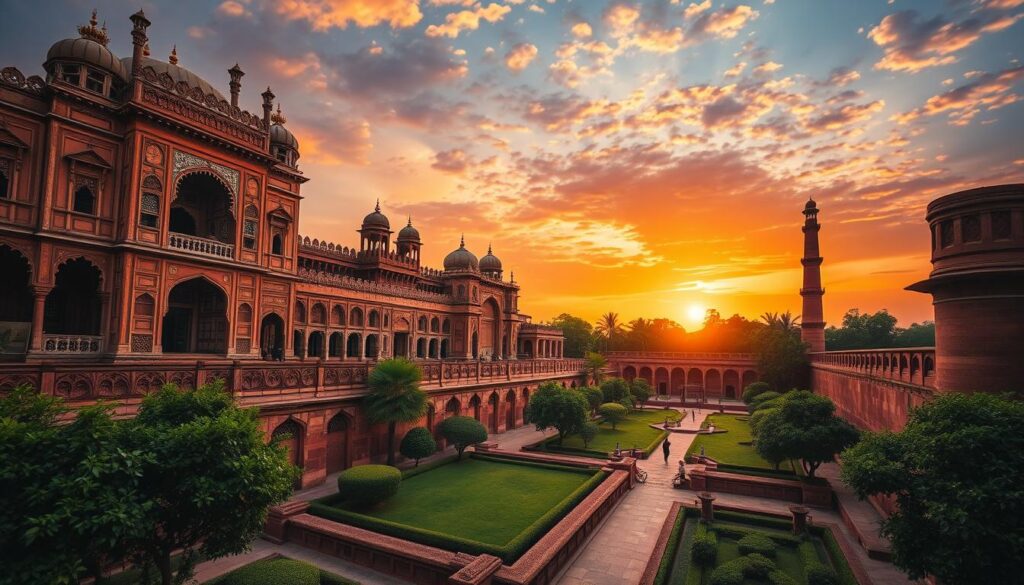
The Badshahi Mosque: A Masterpiece of Islamic Architecture
The Badshahi Mosque was built during Emperor Aurangzeb’s reign in the 17th century. It’s a masterpiece of Islamic architecture. Its massive courtyard can hold over 100,000 people. The mosque’s minarets and domes are a sight to behold, dominating Lahore’s skyline.
The Walled City of Lahore: A Living Museum
The Walled City of Lahore is a living museum of the Mughal era. Its narrow streets, bazaars, and ancient buildings are a window into the past. The Wazir Khan Mosque and Shahi Hammam are just a few of the Mughal-era monuments here. They show the city’s rich history and cultural traditions.
The Mughal Empire’s architectural legacy in Pakistan is a testament to the grandeur and sophistication of this remarkable period in history. From the imposing walls of the Lahore Fort to the stunning domes of the Badshahi Mosque, these monuments continue to inspire and captivate visitors from around the world.
Pakistani Cultural Heritage: A Tapestry of Traditions
Pakistan’s culture is a colorful mix of traditions. It spans from the ancient Indus Valley Civilization to the Mughal era. This diversity is seen in the folk traditions that have been passed down through generations.
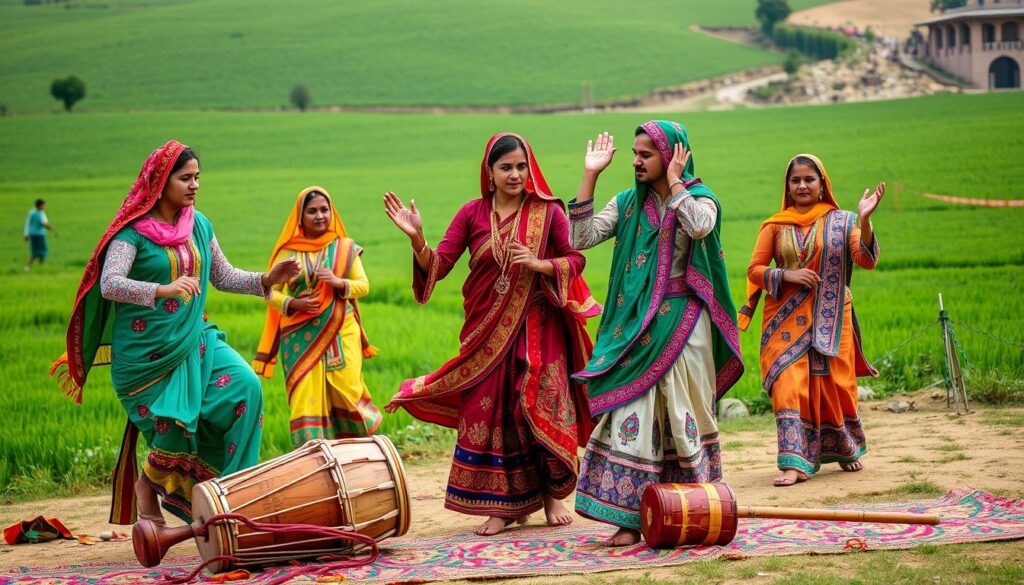
Pakistani folk art is incredibly vibrant and detailed. You can see this in the intricate embroidery of Sindhi ajrak and the colorful truck art on highways. Wood carving and pottery also show the skill of Pakistani artisans. Each region brings its own style and techniques to the table.
“Pakistan’s cultural heritage is not just a source of pride for its people, but also a valuable asset that must be preserved and promoted for future generations.”
But, preserving this heritage is tough. Many historical sites are neglected, and traditional crafts face stiff competition. Young people often don’t appreciate these cultural treasures.
It’s vital to protect and celebrate Pakistan’s heritage. Governments can help by supporting museums and artisans. Education and awareness campaigns are also key to keeping these traditions alive.
In today’s global world, preserving Pakistani culture is more crucial than ever. By celebrating its diversity and traditions, Pakistan can strengthen its identity and enrich global culture.
The Mystical World of Sufi Shrines
Pakistan’s spiritual heritage is deeply connected to Sufism, a part of Islam that focuses on inner growth. Sufi shrines across the country are sacred places for devotees. They seek blessings, find peace, and connect with the teachings of saints and poets.
These shrines are not just spiritual centers but also architectural wonders. They show the rich cultural diversity of Pakistan.
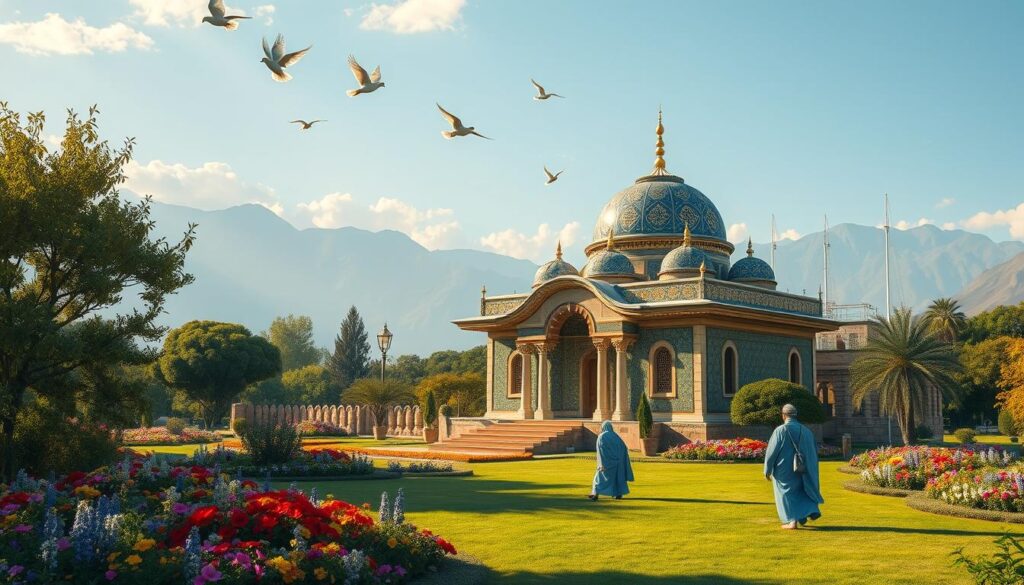
The sufi shrines in Pakistan are more than places of worship. They are living legacies of great mystics. The Qawwali music, vibrant colors, and intricate designs create a deep spiritual atmosphere.
The Shrine of Shah Abdul Latif Bhittai
The Shrine of Shah Abdul Latif Bhittai is a key sufi shrine in Pakistan. It’s in Bhit Shah, Sindh. Shah Abdul Latif Bhittai was a famous Sufi poet and saint.
His verses, known as ‘Shah Jo Risalo,’ inspire many. The shrine’s architecture reflects Sindhi identity. Thousands visit each year to honor the poet and seek blessings.
“The Beloved is all; the lover just a veil,
The Beloved is living; the lover a dead thing.”
– Shah Abdul Latif Bhittai
The Shrine of Data Ganj Bakhsh
The Shrine of Data Ganj Bakhsh in Lahore is another key spiritual site. It honors 11th-century Sufi saint Abul Hassan Ali Hajvery, known as Data Ganj Bakhsh. The shrine is one of the oldest and most revered in South Asia.
The shrine’s Persian-influenced architecture is stunning. It shows the saint’s lasting impact and Sufism’s tradition in the area.
Visitors find peace and connection at these shrines. They immerse in the spiritual atmosphere and join in rituals and practices. From Qawwali performances to moments of prayer, these shrines offer a unique journey of faith and self-discovery.
Vibrant Folk Traditions and Craftsmanship
Pakistan’s culture is rich and colorful, thanks to its folk traditions and craftsmanship. The art of truck painting, intricate embroidery, and textiles are just a few examples. Skilled artisans have kept these traditions alive for generations.
The Art of Truck Painting
Truck painting in Pakistan is truly eye-catching. These trucks are covered in detailed designs, calligraphy, and bright colors. The painters, known as “ustad,” spend hours on each truck. They mix old and new styles, creating something unique.
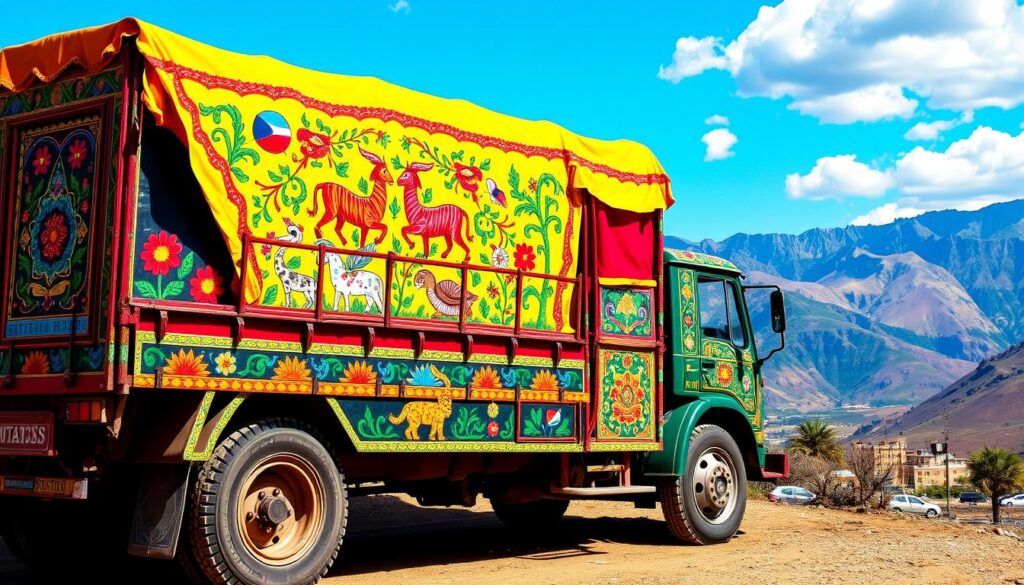
Traditional Embroidery and Textiles
Pakistan’s textiles are a treasure trove of tradition. Ajrak and Kashi work from Sindh and Balochistan are famous. These fabrics are not just beautiful but also carry deep cultural meaning.
The women of Pakistan have been the custodians of our textile heritage, passing down the knowledge and techniques of embroidery from mother to daughter for generations.
The Skilled Artisans of Pakistan
Pakistan is home to many skilled artisans. In Multan, potters make blue pottery that’s loved worldwide. In Chiniot, wood carvers create stunning furniture and decorations.
These traditions add to Pakistan’s culture and support many families. By supporting these artisans, we help keep Pakistan’s heritage alive for the future.
Challenges Facing Pakistan’s Cultural Heritage
Pakistan’s cultural heritage spans millennia, with diverse traditions. Yet, it faces challenges in the modern era. Many sites and practices are at risk due to neglect, lack of resources, and insufficient awareness.
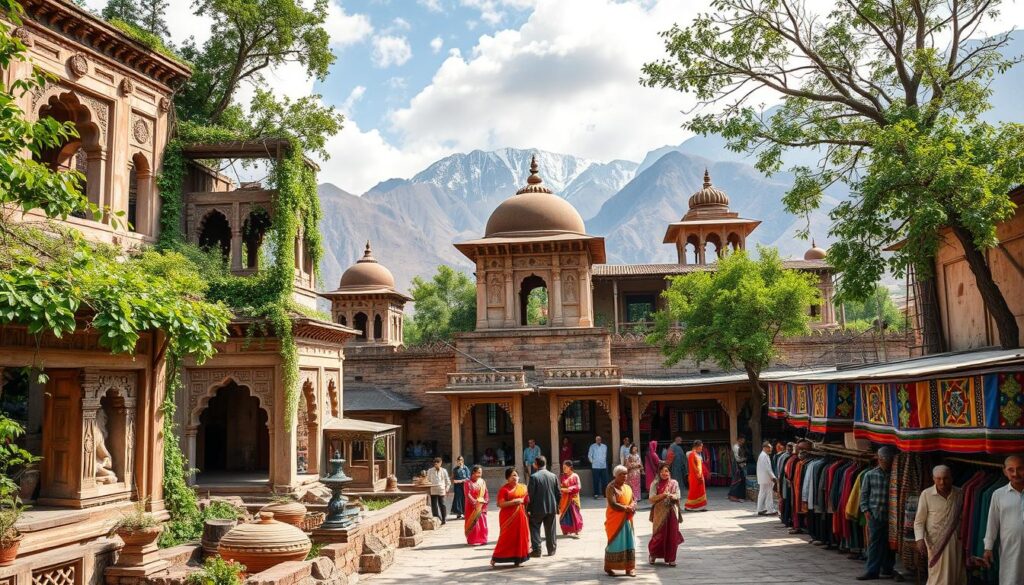
Historical sites in Pakistan are deteriorating. They need conservation and restoration efforts. Without action, these sites may be lost, depriving future generations of their cultural roots.
Neglect and Deterioration of Historical Sites
Several factors contribute to the neglect of historical sites in Pakistan. These include inadequate funding, lack of expertise, and poor management. Many sites have crumbling walls and faded frescoes.
To address these issues, the government must allocate resources for conservation. This includes funding, hiring experts, and implementing regulations to prevent damage.
Lack of Awareness and Appreciation
Many Pakistanis, especially the young, lack awareness and appreciation for their cultural heritage. Modernization and globalization have disconnected them from their roots.
“It is essential that we instill a sense of pride and appreciation for our cultural heritage among our youth. By engaging them in heritage education programs and promoting the value of our shared history, we can ensure that our traditions and cultural treasures are cherished and preserved for generations to come.”
– Sana Ahmed, Cultural Heritage Activist
To foster cultural awareness, heritage education programs are crucial. These can include school curricula, community workshops, and media campaigns. They help celebrate local traditions and highlight historical sites.
By addressing neglect, deterioration, and lack of awareness, Pakistan can protect its cultural heritage. Through conservation, cultural awareness, and education, its traditions and historical treasures will thrive for centuries.
Preserving and Promoting Pakistan’s Cultural Treasures
Pakistan’s rich cultural heritage shows its vibrant history and diverse traditions. It’s vital to protect and share these treasures. This way, Pakistan’s identity stays strong, and its people feel proud.
The government and heritage groups are working together. They aim to restore and conserve historical sites. This ensures these sites remain for future generations to enjoy.
Preserving intangible heritage is also key. Pakistan’s traditional music, dance, and stories are part of its culture. Efforts are underway to record and share these traditions. This helps them live on and inspire others.
Heritage tourism is also important. It lets the world see Pakistan’s cultural wonders. This boosts the local economy and helps people understand and appreciate Pakistan’s traditions.
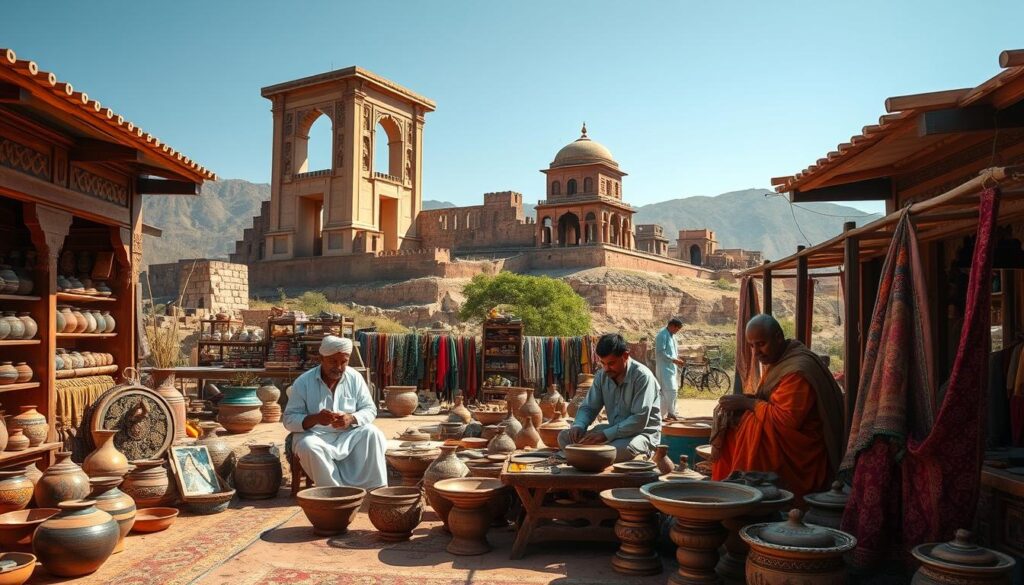
Developing sustainable tourism helps attract visitors. This exchange enriches both the local economy and cultural understanding. International cooperation is crucial for sharing knowledge and resources in preserving heritage.
“Pakistan’s cultural heritage is a treasure trove waiting to be discovered. By preserving and promoting our heritage, we not only strengthen our identity but also build bridges of understanding with the world.
The Pakistani government values cultural heritage preservation. It supports initiatives with funds, cultural centers, and events. These efforts show the government’s dedication to preserving cultural treasures.
As Pakistan celebrates its heritage, it’s important to keep it vibrant. Everyone must play a role, from the government to local communities. Together, we can ensure Pakistan’s cultural treasures continue to inspire and enrich future generations.
Regional Diversity and Cultural Festivals
Pakistan’s culture is rich and diverse, with each region bringing its own traditions. From the north’s valleys to the south’s cities, the country is a colorful mix of customs and celebrations. This diversity shows the depth of Pakistan’s heritage.
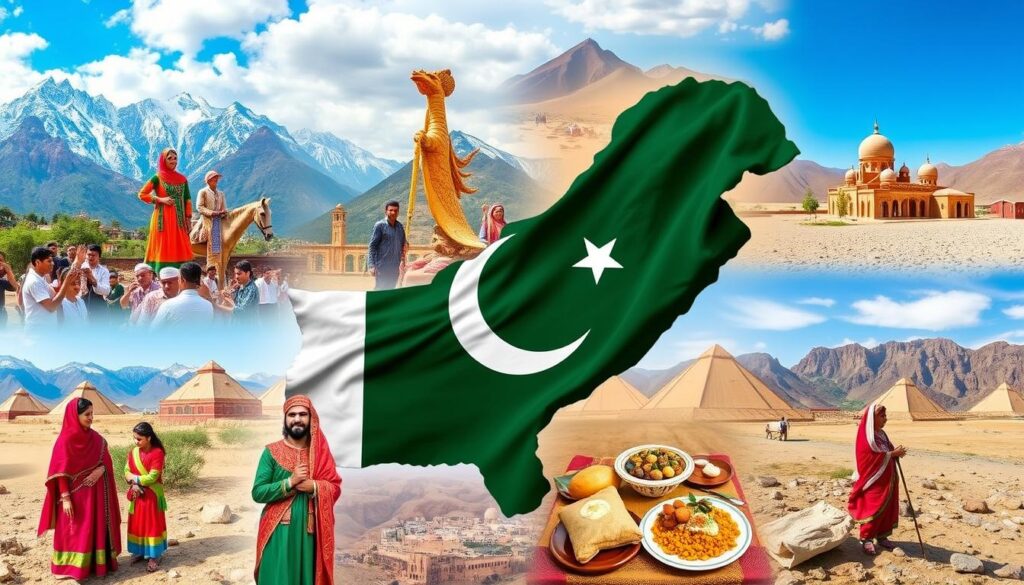
The Kalash Valley and Its Unique Customs
The Kalash Valley in Khyber Pakhtunkhwa is a treasure of ancient traditions. The Kalasha people, with their bright clothes and detailed headdresses, celebrate many festivals. These events highlight their bond with nature and their gods.
The Chilam Joshi festival in May welcomes spring with dancing and singing. The Uchal festival in August honors the harvest, showing gratitude for the land’s bounty.
The Vibrant Colors of Basant Festival
In Punjab, Basant festival is a joyous spring celebration. It fills the skies with colorful kites and the streets with music. Held in February, it brings people together to enjoy the season’s beauty.
Kite-flying competitions are a big part of the festival. People use special strings to cut each other’s kites. The festival also includes colorful processions, traditional music, and tasty treats like gajak and gulab jamun.
The beauty of Pakistan lies in its diversity, and the country’s cultural festivals are a testament to the richness and resilience of its heritage.
These cultural celebrations make Pakistan’s culture even more vibrant. They remind us of the importance of preserving our heritage. By celebrating our diversity, we ensure our cultural treasures continue to inspire future generations.
The Importance of Safeguarding Intangible Heritage
Pakistan is rich in tangible and intangible cultural heritage. This includes traditional music, folk dance, and oral traditions. These cultural expressions are key to the nation’s identity and cultural memory. A global survey in October 2022 targeted over 1,000 stakeholders, showing the growing importance of safeguarding intangible cultural heritage.
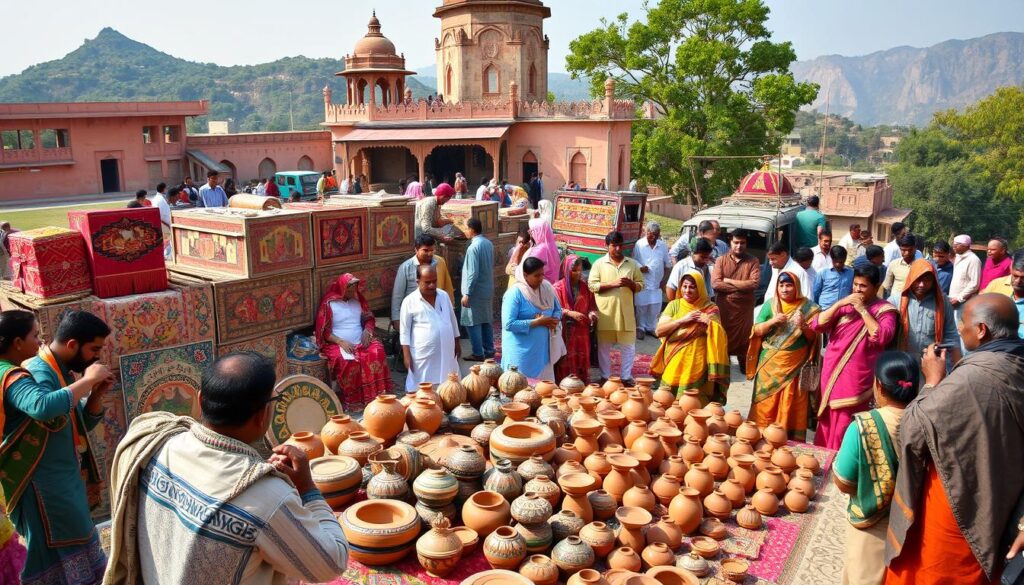
Traditional Music and Dance Forms
Pakistan’s traditional music and dance show the country’s regional diversity. Each has its own unique flavor and charm. For example, the Sindhi Sagar Veena and Punjab’s bhangra dance are just a few examples.
The Intangible Cultural Heritage Fund helps protect these cultural expressions. It supports programs and projects to safeguard intangible heritage. This includes community-based inventorying and safeguarding in emergencies.
“The soul of a nation is found in its intangible heritage, the unwritten stories, the unsung melodies, and the unspoken traditions that bind us together.”
Oral Traditions and Storytelling
Oral traditions, like folk tales and proverbs, are vital for passing down cultural knowledge. They entertain and preserve our ancestors’ wisdom and experiences. A multinational request aims to safeguard the intangible cultural heritage of Afro-descendant peoples in Central America.
Protecting these elements is key to their survival in a changing world. The Secretariat was asked to organize an expert meeting in December 2023. This meeting will focus on safeguarding intangible cultural heritage in the face of climate change. Preserving our intangible cultural heritage honors our past, enriches our present, and secures our future.
Conclusion
Pakistan’s cultural heritage is a rich mix of ancient civilizations, stunning architecture, lively folk traditions, and deep spiritual wisdom. It includes the amazing ruins of Mohenjo-daro and the grand Badshahi Mosque. It also features the mystical Sufi shrines and the detailed work of skilled artisans.
This heritage is a key part of Pakistan’s history. But, it’s facing big challenges like neglect, damage, and a lack of interest from young people.
To protect and celebrate Pakistan’s cultural identity, everyone needs to work together. The government, heritage groups, and local communities must join forces. They should focus on preserving historical sites, recording oral traditions, and supporting traditional arts and crafts.
By doing this, Pakistan can keep its cultural heritage alive for the future. Celebrating the country’s diverse cultures through festivals and events can also build national pride and unity.
In short, Pakistan’s cultural heritage is a valuable treasure that needs to be cherished and shared. By valuing and protecting its cultural treasures, Pakistan can strengthen its identity and add to the world’s cultural richness. It’s up to every Pakistani to embrace and celebrate their heritage, ensuring it thrives for years to come.
- Introduction to Pakistan's Cultural Landscape
- Ancient Civilizations and Their Enduring Legacy
- The Splendor of Mughal Architecture
- Pakistani Cultural Heritage: A Tapestry of Traditions
- The Mystical World of Sufi Shrines
- Vibrant Folk Traditions and Craftsmanship
- Challenges Facing Pakistan's Cultural Heritage
- Preserving and Promoting Pakistan's Cultural Treasures
- Regional Diversity and Cultural Festivals
- The Importance of Safeguarding Intangible Heritage
- Conclusion
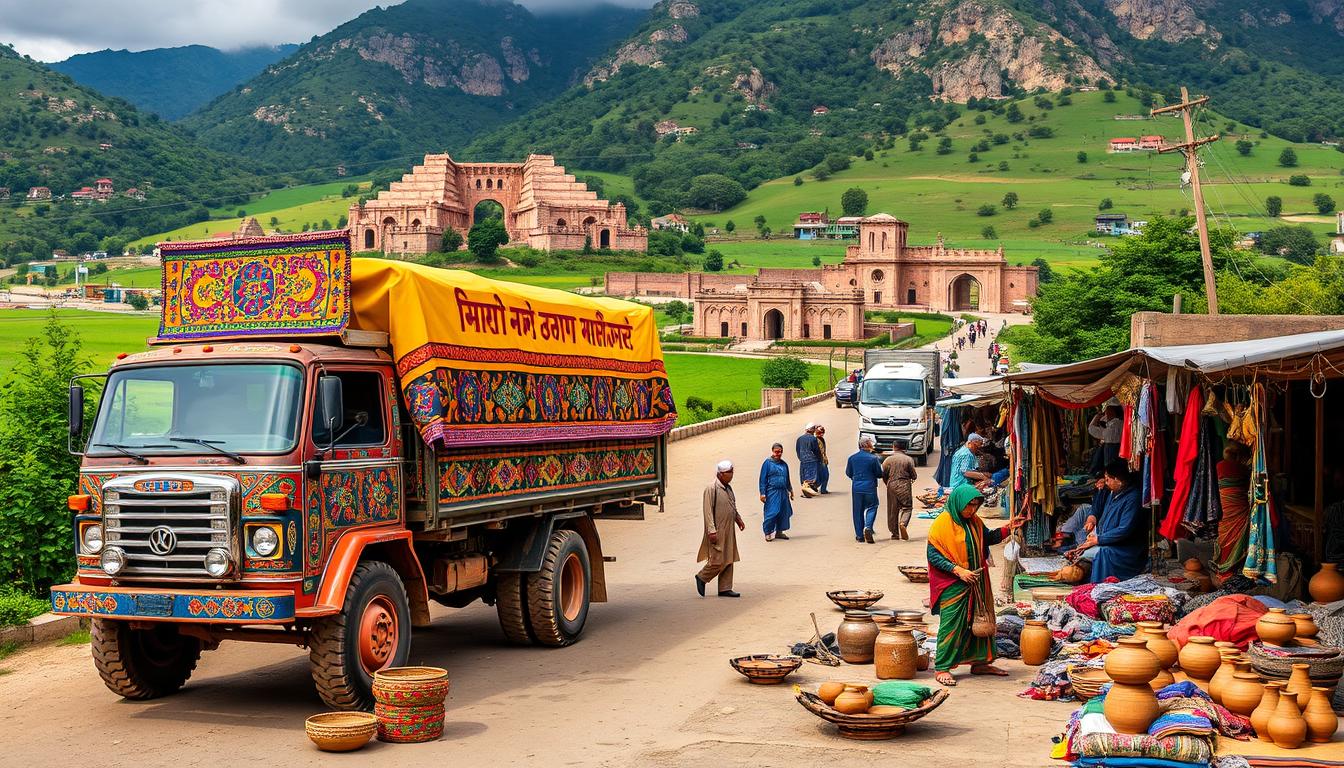
Your blog is like a beacon of light in the vast expanse of the internet. Your thoughtful analysis and insightful commentary never fail to leave a lasting impression. Thank you for all that you do.